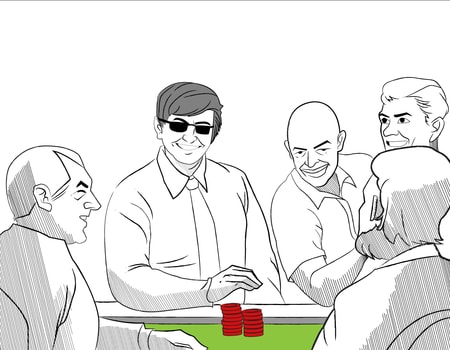 Running a home poker tournament is one of the greatest ways to enjoy the game.
Running a home poker tournament is one of the greatest ways to enjoy the game.
Many great players have started their poker journeys from home poker tournaments. There, people can enjoy comradery along with a unique opportunity to understand their friends.
Home poker tournaments allow for playful banter and a definitive winner. Bragging rights are endless. The drama of key coinflips and big bluffs create incredible excitement for a Friday night. There is truly nothing like it.
Of course, if no one is running a home poker tournament in your area, you can’t share in all this fun. That’s a bummer.
However, if you’re game for a little bit of preparation, then you should consider trying to run a home poker tournament of your own!
It’s honestly not as hard to run a home poker tournament as it looks. All you need is a few minutes to run through this guide.
Table of Contents
Choosing the Right Poker Chips
First off, let’s discuss how to set up poker chips. You want to spring for the good clay ones if you have a couple bucks. Those cheap plastic chips they sell at drug stores are the exact same everywhere. Many people have the same set at home.
You don’t want there to be any temptation for your players. If they can grab a stack of reds from home, and sneak them in during a critical tournament juncture, then you will be in serious trouble. A grave argument will ensue. Even if the angle shooting isn’t discovered by all of your friends, the tournament is still forever compromised.
Save yourself the hassle. A great set of 500 chips will run you around a $100, but you’ll literally be able to hand them down 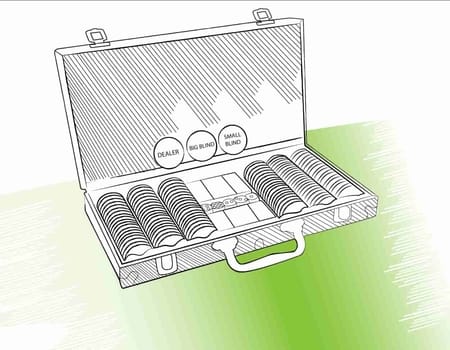 to your kids. The clay ones are durable!
to your kids. The clay ones are durable!
As strange as it sounds, poker players LOVE playing with their chips. They like the weight of the real clay ones. It makes shuffling much easier. The game comes alive when you put heavy chips into the middle and feel the weight of a real pot when it comes back to you.
Make sure the chips have numerous denominations. If the value of the chips is printed on each individual chip, that’s a plus, but not necessary. It will, however, greatly help novices to your game.
You don’t want to have only three or four colours. The problem you’ll run into is that as the tournament goes on, you’ll quickly run out of each denomination. If you have multiple colours, then you can always colour up a player who is taking all the small chips off the table.
Familiarise Yourself with the Tournament Rules
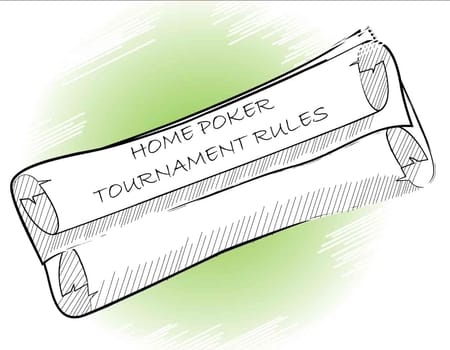 As for home poker tournament rules, you should have a standardised set printed before the game. That way if there is a dispute you can refer to something physical to make your decision. This setup will appease all fears of favouritism that your tournament participants might have.
As for home poker tournament rules, you should have a standardised set printed before the game. That way if there is a dispute you can refer to something physical to make your decision. This setup will appease all fears of favouritism that your tournament participants might have.
You can even just print the tournament rules from a large poker tour if you want. Most of the large tours post their rules on their site. Many of your players will actually find it quite neat that you’re using the same rules.
A fun rule you can add to your guidelines is a $5.00 penalty on any player who cusses or mocks another player. This money can later be used to buy pizza for everyone who attends a poker tournament.
The Ups and Downs of Getting Paid
Speaking of money…
What should a home poker tournament payout structure be like? It depends on your clientele. If you have a more casual set 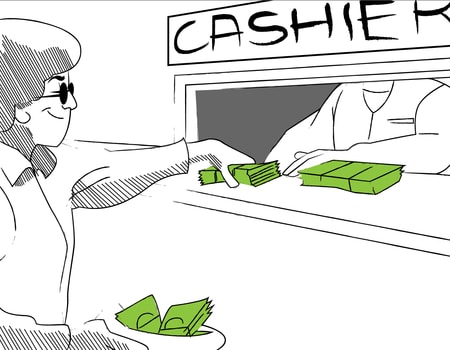 of players, then you should opt for a flat payout structure.
of players, then you should opt for a flat payout structure.
Give everybody a fair chance of at least making their money back, and they’ll keep coming back for more.
However, if your friends are adventurous and want to smack talk more, then you should consider a top-heavy payout structure. You can even do winner-take-all tournaments, on occasion, with small buy-ins, just to really turn up the heat!
How do you figure out how much to pay each person? Standardised poker tournament software can do it for you. We’ll get into that more in a minute.
If you don’t have the software, however, you can use these payout structures:
- With ten players or less, pay out 50% of the prize pool to the winner, 30% to second place, and 20% to third.
- With 11 to 20 players, pay out 50% of the prize pool to the winner, 25% to second place, 15% to third place, and 10% to fourth place.
- With 21 to 30 players, pay out 40% to first place, 25% to second, 20% to third, 10% to fourth, and 5% to fifth.
Make Sure the Blinds Aren’t Leading the Blinds
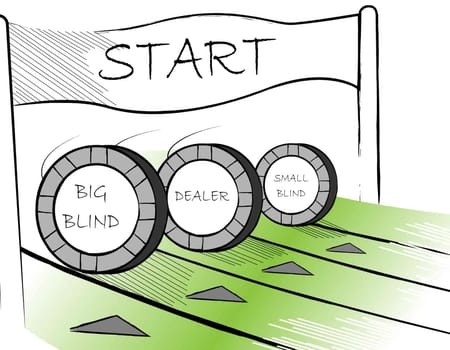 Now, let’s discuss a home poker tournament blind structure. Generally, you’d like your tournament to work like a daily tournament at a casino. Most home poker tournament players want the action to wrap up in three hours.
Now, let’s discuss a home poker tournament blind structure. Generally, you’d like your tournament to work like a daily tournament at a casino. Most home poker tournament players want the action to wrap up in three hours.
You can simply grab a structure sheet from your local casino which deals with similar field sizes, and duplicate it. You can also use the suggested structures in many home poker tournament programs.
However, if you’re bereft of either of these items, you can just have your players start with 5,000 chips and 25/50 blinds. Double the blinds every 15 minutes. Add an ante at 200/400 of roughly 1/8th the big blind’s size.
This will give you a fast and fun tournament with twenty or so people, finishing up after two hours or so.
If everybody decides they want a slower tournament next time add a 300/600 level. If players still want a longer tournament, add 150/300 and 500/1000 levels.
A good rule is that a tournament will frequently finish during the round when the big blind reaches 5-10% of the total chip count. That will help you decide on the number of levels you want to implement, once you consider how much time your players want to play.
I’d recommend around three or four hours of play time, with an optional cash game for players who busted.
Keeping the Clock Ticking
How do you keep time? A home poker tournament timer can be many things. You can use your cell phone or an egg timer. My recommendation, however, would be to use some software.
Poker tournament software for home games is cheap and available now. You can set it up on your laptop, connect the device to your flat screen with an HDMI cable, and allow all your home poker tournament participants to know how much time they have left in the level. Even more fun, many of these programs display the average stack, the number of players left in the tournament, and payout structures.
Just remember to try the software before you buy it and use it at your own home poker tournament! You don’t want to be finding out the software’s glitches when you have 30 people over. Most of the software out there has a trial period. Download it and hold a heads-up freezeout with one of your friends or play a game with the family.
To further assist matters, make it clear what the poker chip values are in your home game. You can post a guide somewhere near all the tables.
Make sure the tables are not made of glass, by the way. People will be able to sneak a peek at their opponent’s cards if they’re made of glass. It’s amazing how many people will miss this when they throw their first poker tournament.
Making Your Poker Tournament Special
Once you start feeling comfortable with everything discussed above, then you can start having more fun with your poker  tournaments.
tournaments.
- You can introduce a “bounty” night. Player’s will contribute an extra small amount to the buy-in. That will be their bounty. If someone knocks this player out, they will receive that player’s bounty. At the end of a player’s run, they can cash in all their bounties.
It’s good to mark bounties with a chip that’s not from the traditional poker set. The player can collect that chip when the player busts. You can use the cheap drug store chips for this because no-one is going to be smuggling in extra bounty chips. It’ll be too easy to count up all the bounties at the end of the night and discover the deception.
- You can also throw a “turbo” night and try to throw two tournaments in one evening. Cut the level times in half, turn on some faster techno music, and encourage faster play. This variation can be a ton of fun.
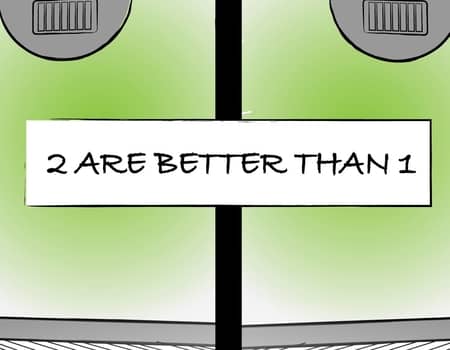 Don’t use an actual shot clock, though. Shot clocks are welcome in major live poker tournaments where “time-banking” has become an epidemic, but they are not necessary with a casual audience. Shot clocks will only serve to start arguments and spook your novice patrons.
Don’t use an actual shot clock, though. Shot clocks are welcome in major live poker tournaments where “time-banking” has become an epidemic, but they are not necessary with a casual audience. Shot clocks will only serve to start arguments and spook your novice patrons.
- You can also throw satellites, where winners proceed to a larger tournament to be held weeks later. This format can allow for a “tournament of champions” that really gets players amped up!
You can also have satellites that boost players to large live tournaments. Many home poker tournaments send players to small WSOP events every year.
Home Poker Tournament Variations
You can also throw more home poker variations in the mix. Simple variants like Pineapple and Tahoe are great fun with a good group.
- For those of you who do not know what those games are, Pineapple is a game where you get three cards, but then you must discard one card before the flop or on the flop. The host can decide which variant they prefer.
- Tahoe is a game where players are dealt three cards, they keep the entire hand. Traditional Tahoe only allows players to use two cards in their hand, one, or none at all, but some home games allow players to use all three cards.
- Pot Limit Omaha is a great game, but the two-card usage rule confuses new players.
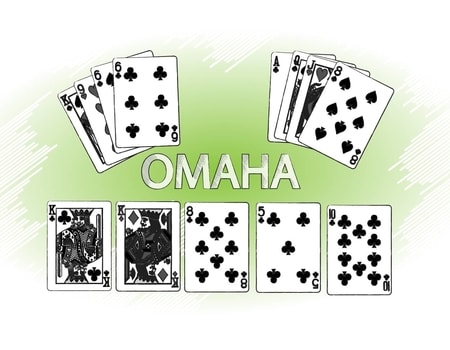
- My favourite home poker tournament variant is Pot Limit Seven-Card Stud, but you never see it played for a reason: It will leave your nerves ragged. All the rounds of betting see players busting left and right. It’s also hard to deal with many players not knowing how to deal Seven-Card Stud anymore.
- Home poker tournament prizes are another way you can have fun. You can charge an extra $1.00 with the buy-in and put it into a bad beat jackpot. Just remember to make the qualifying hand not too difficult, say a full house without two pair on the board.
You can also use the money to buy cheap sports tickets, poker chips, or plastic cards. You can then set a date for those gifts to be given to the winner of a tournament.
Secret Tips to Winning at Home and Away!
Now, obviously, we want to win when we play our own home poker tournaments. So, let’s focus on doing that now.
Don’t Get Scared by Big Pots
 For one, most casual players do not understand how many hands you can move all-in with, in tournament poker, especially when your short stacked. You’ll see them fold some truly ridiculously good hands when you move all-in!
For one, most casual players do not understand how many hands you can move all-in with, in tournament poker, especially when your short stacked. You’ll see them fold some truly ridiculously good hands when you move all-in!
To know what hands, you can move all-in with, I’d recommend you download the Float The Turn app to your phone. That software will have you entering how many big blinds you have and what position you’re in. Then, it will tell you mathematically what hands you should be moving all-in with.
You can also refer to this handy article from 888poker for more advice on all-in poker.
If you stick to just those guidelines and play tight poker at the beginning, you’ll be surprised by how many tournaments you’ll walk away with.
Look for Basic Tells…They’re Everywhere!
Another way you can get an edge on the field is by looking for ostentatious behaviour and baseline behaviour.
Ostentatious behaviour means a flick of the chips, a flourish with the hand, an intense look at the pot, a long look at an opponent…anything that seems oddly visible.
Most players have the same reaction when they get dealt a good hand: They quiet their body language. They are like a tiger waiting in the bushes to pounce with their aces. They don’t want to make a sound!
So, if you’re considering raising and a player makes a loud sigh behind you, then you know that player does not have their best hands. They could still have a decision with Ace King or Tens, but they don’t have Aces or Kings.
Baseline behaviour refers to how nervous a person is with or without a hand. Many people are nervous with or without a hand, and some cool customers are the reverse. That said, many people do not fit this mould.
Many guys will look bored out of their minds with a big hand because they feel they have nothing to worry about. If you see this same player clam up in a close spot, then you know it’s unlikely they have a big hand.
Some good players are the opposite. They will feel calm bluffing, but when they get a big hand, they will get excited. Then, they will be nervous!
If you see the same players every week then just pay attention when they’re in hands. You’ll eventually get a feel for what raises a player’s blood pressure.
Reading tells is a good habit to develop. It will come up throughout your entire poker career. You can use these same tells in major live tournaments.
Get Money From Your Good Hands!
Another good strategy to remember in live poker tournaments is the value of small bets. Recreational players have a hard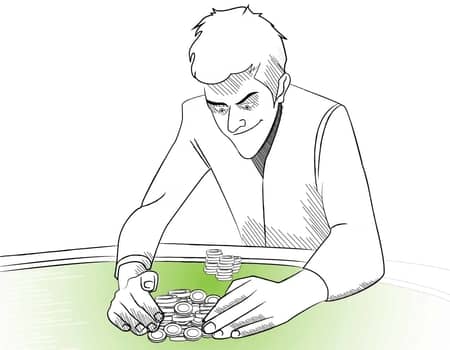 time folding. Actually, all poker players have a hard time folding. People drive somewhere to PLAY poker…not to fold. That said, recreational players REALLY have a hard time folding, so you should bluff sparsely, if ever.
time folding. Actually, all poker players have a hard time folding. People drive somewhere to PLAY poker…not to fold. That said, recreational players REALLY have a hard time folding, so you should bluff sparsely, if ever.
However, if you flop a good pair, you should be willing to bet small on multiple streets. Many recreational players will call you with anything halfway decent all the way through to the river! This fact will see you padding your stack nicely for the bigger blind levels.
Again, don’t get scared by big pots. You will burn yourself on occasion, but this is where you will separate yourself from the pack. If you can make good money when you have good pairs, then you will do better than your opponents.
Position Is Everything
Before we finish this article today, let’s talk about that age-old poker maxim: Position matters. This statement is doubly true in home games.
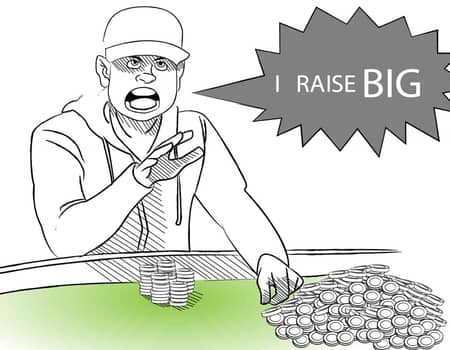 If you open a hand like A-Jo or K-Qo in early position, you can expect to be called by numerous players. Home poker tournaments tend to be loose, and this scenario is a big problem when you have big cards.
If you open a hand like A-Jo or K-Qo in early position, you can expect to be called by numerous players. Home poker tournaments tend to be loose, and this scenario is a big problem when you have big cards.
Why? Big cards make big pairs. That’s wonderful when you’re in a heads-up pot, but in multiway pots, it’s far more likely you’ll run into two pair or better by the river. That situation is likely to cost you big time. If you want to beat home poker tournaments, then keep it honest in position.
Don’t be afraid to raise limpers either! Just remember, you have to raise big! Raise 4X the blind PLUS 2X the big blind for each limper (and count the big blind…pretend the big blind player limped).
This amount will give you a big raise that is likely to get called by one bad player, or it will force everyone to fold. If you keep picking up those orphaned limps you will drive your way into the winner’s circle. Just remember: If your isolation raise size is more than 30% of your chips, just go ahead and move all-in.
I hope these tips will help you run the home poker tournament of your dreams and eventually win it!
Your friends prefer to stay at home? you can always login to 888poker, open a private home game and play poker with your friends online.
Good luck to all of you!
